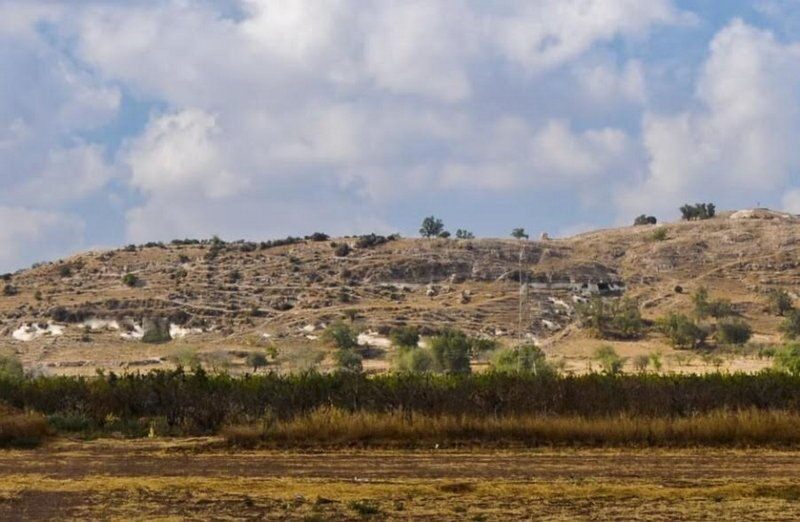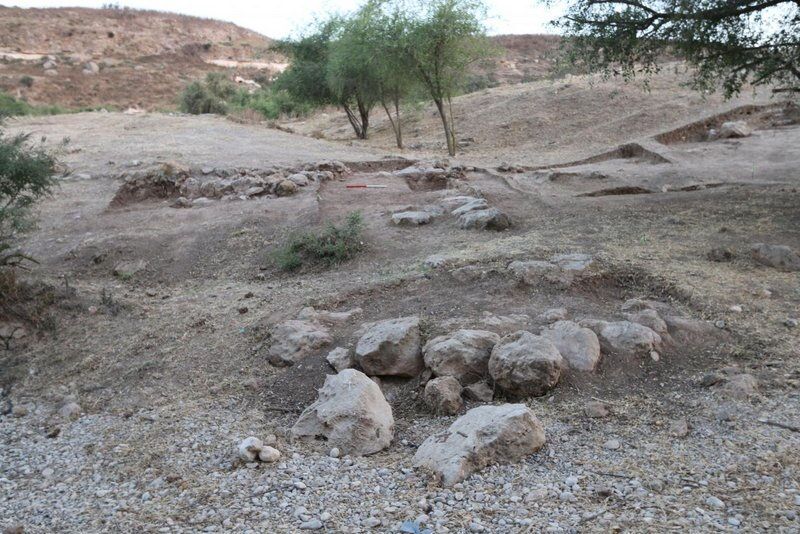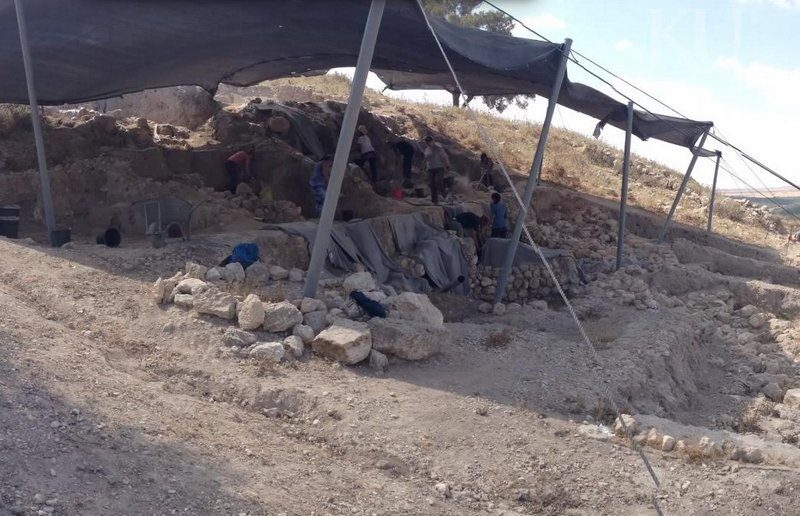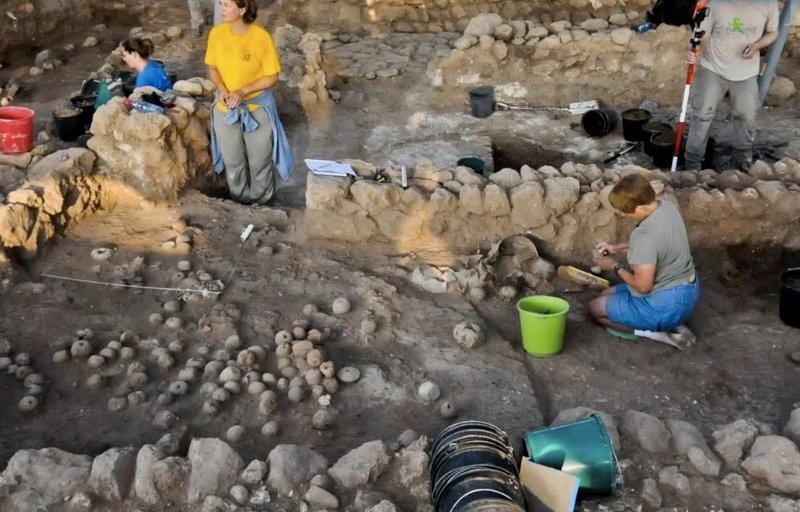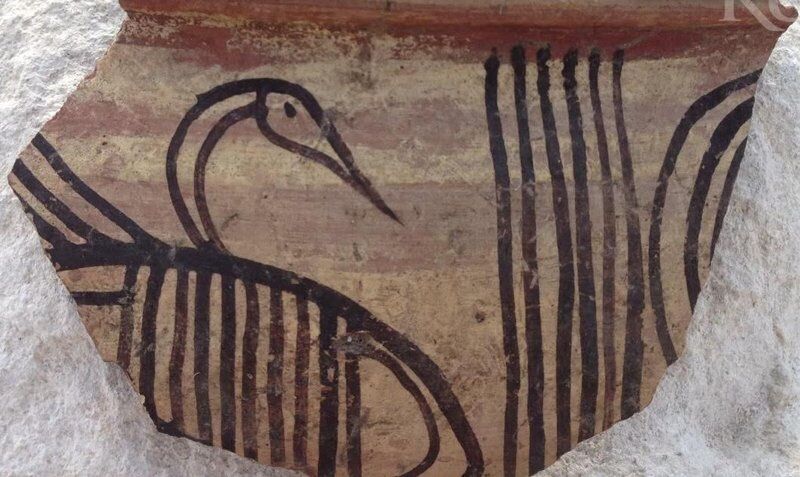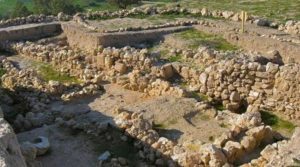
For more than 30 years, archaeologists have unearthed a wealth of finds bearing on the ancient Philistines, a people perhaps best known from the Bible as the arch enemies of the Biblical Israelites. Monumental evidence of their presence has already been revealed through the exposed remains of sites such as Ashdod, Ashkelon, and Ekron. Thriving between 1200 and 600 BCE on the coastal plain of what is today called Israel, they built cities, built a powerful local military force, and, indeed, even spread their influence beyond their original cultural boundaries into the land of their Judahite neighbors.
Of all the Philistine cities, however, only one can be directly associated with one of the best-known and popular stories of the Bible—that of David and Goliath. Goliath, according to the Biblical story, hailed from Philistine Gath.
But for most of the last 2500 years, Gath has been lost. Not to memory – but to sight. For years, its actual location has been grist for scholarly debate, not unlike the story of other biblical sites once lost and found. Today, however, it can be confidently stated that most scholars would place the long-lost Gath at the archaeological site of Tell es-Safi, a location where Bar-Ilan University’s Prof. Aren Maeir has been excavating along with generously staffed teams of archaeologists, students and volunteers for over two decades. Situated about halfway between Jerusalem to the east and the ancient coastal Philistine city of Askelon in the west, Gath, along with its similarly located ancient Philistine sister city of Ekron not far to its north (Tell Miqne), has thus far yielded evidence of human occupation reaching as far back as Chalcolithic times, or about the 5th millennium BC. Excavations have also revealed impressive monumental remains of an underlying Canaanite city dating from the Early Bronze Age.
__________________________________________
The visible mound of Tell es-Safi on the landscape. Still screenshot from video, KU professor and students help uncover ancient Biblical city of Gath, YouTube 11 August 2015.
____________________________________
New Discoveries
Arguably one of Maeir’s finest eureka moments came, however, when he and his team began to realize that they had encountered the beginning traces of monumental structures that could potentially reveal a motherlode of new information about the city that existed at the time of Philistia’s biblically famous warrior.
“We found the very large and impressive fortifications of the city, and very likely the city gate as well, dating to the Iron Age,” said Maeir.*
Although this area of the excavation was still very much in the early stages at the time of this writing in 2015, archaeologists were already seeing the unmistakable outlines and dimensions of the fortification complex. Said Eric Welch, a key participating archaeologist from the University of Kansas: “We have a city wall that appears to be about 2 meters thick, and we’ve traced this for over 30 meters. On the outside of this fortification system are larger towers or outbuildings, and right through the middle of this we have a large opening – a depression – that looks like its going to be the entrance to the city itself.”**
_________________________________________________
Above: A view of the excavated remains of the Iron Age city wall of Philistine Gath. Prof. Aren Maeir, Director, Ackerman Family Bar-Ilan University Expedition to Gath
_____________________________________________________
View of excavated Iron Age fortifications of the lower city of Philistine Gath. Prof. Aren Maeir, Director, Ackerman Family Bar-Ilan University Expedition to Gath
________________________________________________________
Aerial view of excavations. Screenshot still from video, KU professor and students help uncover ancient Biblical city of Gath, YouTube 11 August 2015.
_____________________________________________
Above and below: Excavators at work on site. Screenshot still from video, KU professor and students help uncover ancient Biblical city of Gath, YouTube 11 August 2015.
_____________________________________________________________
The findings have important implications. A city gate is recorded in the Bible (in 1 Samuel 21) in reference to David’s flight from King Saul to seek refuge with Gath’s King Achish. Moreover, explains Maeir, “Up until now we knew the size of the Iron Age period site but we couldn’t show that it was actually fortified. Now we see that it was not only the largest city in the land for its time but also it had perhaps the most impressive monumental fortifications. It tells us something about the character of the city and its importance compared to other cities and other states in the land at the time.”
“For example,” Maeir continued, “if you think about the relationship between Gath and the Judahite kingdom at the time, very often we think of the kingdom of David and Solomon as a kingdom that was more or less the size of the empire of Constantine [according to the Biblical account]. But the question is, [archaeologically speaking] how big was the kingdom of David and Solomon? If this city [Gath] was large, fortified, very dominant, then it most probably meant that the Judean kingdom could not expand westward, so that means that we’re limiting at least in that direction how large the kingdom was.”*
The findings also mean something in terms of further illuminating the nature and life-ways of the Iron Age city.
“In ancient cities we always know that the gate was a focal point, it was one of the civic centers,” explained Maeir. “That’s where a lot of commerce went on, that’s where judicial issues were addressed, that’s where cult activities were conducted, and we know from many archaeological sites that a lot of interesting finds are often found at the city gate. It could very well be that, in finding the gate, we will have a very nice view of what the city of Gath was like in ancient times. And what makes this so fascinating is that this entire area of the gate, including the fortifications all around it, is completely devoid of later remains. That means that we can basically scratch the surface and [immediately] get to the remains from the time of the Iron Age……For the next few seasons, we’re gong to have a lot of cool finds.”* Remains of a temple and a stone altar have already been revealed in the area, and during 2015 the team uncovered evidence of metallurgical and textile production activity.
The Philistine Remake
The Philistines have traditionally been thought to be descendants of what many scholars have called “Sea Peoples”, groups of Late Bronze Age colonizers from Greece, Cyprus, Turkey, the Balkans, and other Aegean locations, who brought their respective cultures with them and built new lives in a new land already firmly occupied by the Canaanites. What happened after they arrived, Maeir explains, has been illustrated by the archaeology he and his other colleagues have conducted over at least the last 20 years.
Contrary to the traditional view, Maeir states “when they came to Canaan they didn’t destroy the Canaanite cities. We don’t have evidence of major destructions. Rather, they settled in the Canaanite cities with the Canaanites and together with them formed a very unique culture—what we call an entangled culture, a mixture. This culture continued to exist for about 600 years, from about 1200 to about 600 BCE.”*
Moreover, based on the archaeological evidence, the Philistines and their neighbors the Israelites experienced a relationship seemingly far more complex than that of mutual enmity. “We see a picture of both enmity on the one hand and on the other hand a lot of interconnections – Philistines influencing Israelites and Israelites influencing Philistines,” said Maeir. “So for example, recently, not far from Jerusalem they excavated a Judahite temple from about the 10-9th centuries BCE but within the temple they found figurines which are very similar to Philistine figurines. On the other hand, at Gath, we excavated a Philistine temple from the 9th century and in that Philistine temple we found a stone altar very similar to the stone altars that we know existed in Israelite temples, and a fascinating find right next to the altar—[there was] a jar with an inscription, a Judahite name, a jar made in the region of Jerusalem. That means someone from Jerusalem, a Judahite, took a jar and offered it to the Philistine temple. So the whole concept of a clear-cut [cultural and geographic] border between Judah and Philistia may not have really existed.”*
In other words, the distinction between Judahites and Philistines is likely more blurred and complex than the traditional image reflected in the Biblical text. Maeir and colleagues hope that the continuing excavations at Tell es-Safi will shed additional light on this emerging complex relationship.
___________________________________________
Above: Example of typical Philistine pottery style. Screenshot still from video, KU professor and students help uncover ancient Biblical city of Gath, YouTube 11 August 2015.
____________________________________________
Stone altar found within the remains of a Philistine temple at Tell es-Safi. Screenshot still from video, KU professor and students help uncover ancient Biblical city of Gath, YouTube 11 August 2015.
_____________________________________________
Much more than the recent Iron Age fortifications, Tell es-Safi/Gath has already amassed an impressive list of significant finds that tell a story of a city with a commanding presence in the history of the region. Among the findings to date:
Philistine temples dating to the 11th through 9th centuries BCE; evidence of the first Philistine settlement in Canaan; the earliest decipherable Philistine inscription ever discovered, featuring two names similar to that of Goliath; remains of the earliest siege system yet discovered in the world, interpreted to have been constructed by King Hazael of Aram Damascus in about 830 BCE, including evidence of Hazael’s capture and destruction of the city; prolific remains of the earlier Canaanite city; signs of a major earthquake in the 8th century BCE; and the remains of the Crusader castle known historically as “Blanche Garde”, where King Richard the Lion-Hearted is recorded to have been. More than that, and perhaps most importantly, the excavations have shed additional light on the everyday lives of a people long vanished. Said Welch of the 2015 season: “Up in Area F where the KU team was working we have a large city wall that dates to 2500 BC or what we call the Early Bronze Age and then behind that we have progressive layers of rooms that were built up against the city wall, using it as an outer wall. These are domestic structures, basically living spaces where we are finding cooking pots, small votive vessels…….just the things you would associate with a typical domestic context.”** And excavated plant remains at the site, along with similar remains uncovered and analyzed from other known Philistine sites in Israel, have recently shown how the Philistines introduced new plant varieties and agricultural practices into the ancient land, significantly influencing the floral biodiversity.
____________________________________________
Above: Aerial view of some of the Bronze Age remains unearthed at Tell es-Safi. Screenshot still from video, KU professor and students help uncover ancient Biblical city of Gath, YouTube 11 August 2015.
_____________________________________________
Archaeologists say that excavations and research at the site will likely continue for many years to come. The efforts have been joined by a coalition of participating institutions, including the University of Melbourne, the University of Manitoba, Brigham Young University, Yeshiva University, University of Kansas, Grand Valley State University of Michigan, and several Korean institutions, to name some. Vastly interdisciplinary in nature, the work at Gath will reflect a range of research and academic interests focusing on a time and place that, for many, and for different reasons, represents an important place in an important part of the world.
But on behalf of the hundreds of professionals, students and volunteers who have worked at the site, Maeir has expressed it best of all. Ultimately, he says, there is one best reason to do archaeology—plain and simple, “it’s because it’s fun.”*
More about the excavations project at Tell es-Safi can be found at the project weblog.
________________________________________________________
*From radio interview of Aren Maeir by Eve Harow, Rejuvination with Eve Harow, Voice of Israel, 16 August 2015.
**From video, KU professor and students help uncover ancient Biblical city of Gath, YouTube 11 August 2015.
Image, second from top, right: David in combat with Goliath. Aquatint by R. Earlom, 1766, after S. Rosa. Wellcome Trust Images, Wikimedia Commons
________________________________________________________
Subscribe to Popular Archaeology Premium. Available on all laptops and mobile devices, and still the industry’s best value at only $9.00 annually.
___________________________________________


